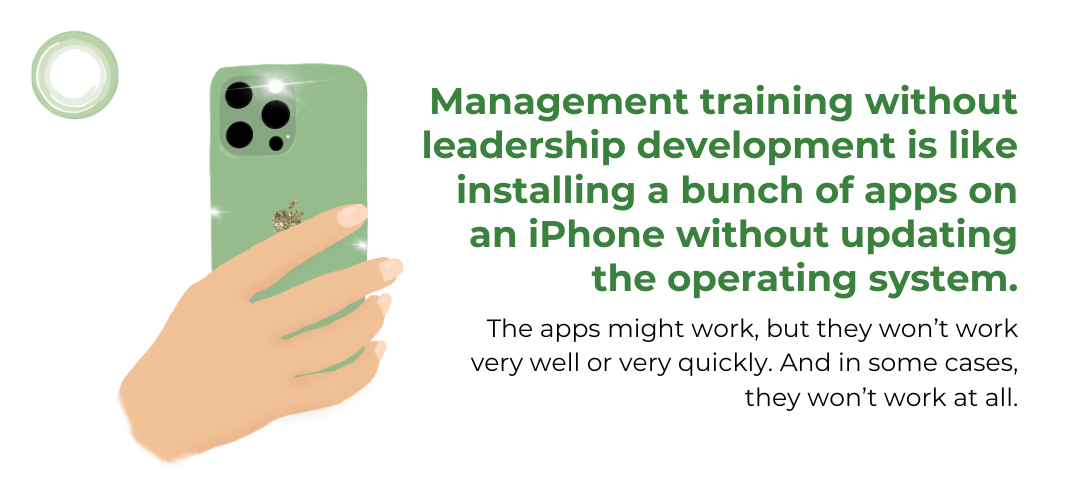What’s the difference between management training and leadership development programs? And why should you care?
Picture this: it’s 7 pm on a Friday night after a long, stressful week. You’re looking over the budget for the next quarter and it’s pretty clear that something’s got to give.
You obviously can’t put off building maintenance and layoffs are not on the table. There, halfway through the spreadsheet you see two things that might be duplicates — management training and leadership development. Surely you could cut one of those.
What’s the difference between leadership development and management training anyway — aren’t they kind of the same thing? Why would you need both? And isn’t your team better served by learning a new type of software than, say, figuring out their Enneagram type?
If this is a conversation you’ve had with yourself (or your accounting department), I get it. And if you’ve ever worried that you’re “double dipping” by giving your team management training and leadership development, you’re not the first CEO to wonder about this.
How leadership development is different than management training (and why your team needs both)
Management training is logistical; leadership development is psychological.
Need both strategy and self-awareness on your team? Explore how we pair tactical management training with deep leadership development to unlock individual and team performance.
A typical management training program might include topics like performance management, communication, conflict resolution, time management, ethics, policies and procedures.
Meanwhile, leadership development covers topics like the way mindset and assumptions fuel performance, how personality type affects leadership style + communication, and how we can leverage these personality types to lead effectively and build amazing teams.
Or in slightly more relatable terms:
Management training without leadership development is like installing a bunch of apps on an iPhone without updating the operating system.
The apps might work, but they won’t work very well or very quickly. And in some cases, they won’t work at all.
Imagine a management training on how to give effective feedback. If your employees haven’t done any leadership development, they might be following the script for how to give feedback, but the way they do it could still be ineffective. If they have complying tendencies (pleasing, belonging, passive) they might sugarcoat their feedback and water down the message.
Similarly, if your employees have protective tendencies (arrogance, critical), they may deliver that feedback in an excessively harsh and unproductive way.
If your employees don’t have the self-awareness to know the way they are coming across and how their own ego or desire to stay safe is influencing their delivery, the management training won’t work — that’s why leadership development and management training go hand in hand.
Put another way: Your effectiveness is often 10% substance, 90% delivery.
And to return to the iPhone analogy: Does it take a while to update an operating system? Are we all inclined to put if off? Do we try to deny the need for it and hobble along, performing at 70% of what we’re capable of? Yes, yes, and yes! This applies to our phones and ourselves.
But when we take the time to update it, we’re amazed by the difference and how much faster and easier everything is.
Want your leaders to deliver feedback with confidence, clarity, and care? We teach that in our Leadership EDGE cohort program, tailored for rising and senior leaders.

The further someone advances in their career, the more they need leadership development (and the more they know they need it).
By the time someone reaches a VP level, they’ve weathered their fair share of logistical, systemic leadership challenges. But they’re much less likely to understand how they’re self-sabotaging or why they keep inadvertently hiring “yes men” or how to get their team to give them honest feedback. It’s at this point they discover that what got them “here” won’t necessarily get them where they want to go. They know they need more than another training to truly up level their mindset and teams.
Team members who feel like their employers aren’t investing in their growth are more likely to quit. And employee turnover is expensive.
A 2018 study of 25,000 people found that employees who don’t feel supported in their professional goals are three times more likely to be looking for a new job. Replacing an employee with a salary of $45,000 costs a company $15,000; increase that number proportionally for replacing senior team members.

When team members get the leadership development they need, they feel supported and invested in.
And when they feel supported and invested in, they’re more likely to stay in their jobs.
And when they stay in their jobs, they can apply all the amazing things they’ve learned in their leadership development to their team, affecting positive changes across the entire company.
Software training can’t do that.
To learn more about how to integrate management training and leadership development programs, contact us.


